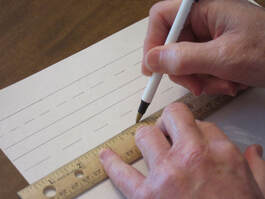So, if you are teaching a preschool or kindergarten child, start with the alphabet. Teach both the capital letters and lowercase letters. Teach them separately. Then mix the capital and lowercase letters together, not in alphabetical order and not in pairs, to make sure that children can identify both capitals and lowercase letters. Rearrange the alphabet letters so that the child is looking at the letter and identifying the letter, not just remembering it from the song
Don’t try to teach reading before you have even laid the foundation for learning about words. Teach the alphabet first. Then, you will have a much stronger foundation for teaching reading later.
This is the kind of foundation that vowel clustering is built upon. Once the child has letter identity, letter shape, and letter sounds, then you are ready to introduce simple words, but not before. It’s like building a house. Build the foundation before you try to add the roof.
Handwriting and reading are connected, so, if you want to teach a child to read, you must also teach a child to write. Improving a child’s handwriting is one of the first steps in helping a child learn to read. It is not enough to just be able to sing the alphabet song; although, the alphabet song is very helpful in learning to alphabetize. To read, the student must also be able to identify and say the name of each alphabet letter. Then, the student must be able to write the letters correctly.
Teach handwriting on manuscript writing paper. I have children use paper that has half-inch ruling with a dotted midline. Yes, I know that it is hard to find supplies, and we are not allowed to go out shopping right now, so, if you need to, make your own manuscript paper. You can even use scrap paper or old left-over wrapping paper. Use the back of a page. Draw a baseline with a dotted midline and half-inch ruling between. Use a ruler and maybe a T-square, it’s not difficult to make your own paper. You might also find downloadable templates for manuscript paper. Make sure that they use half-inch ruling with a dotted line in the middle.

For very young children or children having trouble shaping their letters, write out dotted letters on the manuscript lines for the children to trace. Children enjoy using a colored pencil and tracing over each letter several times to see if the color changes. Teach children to trace exactly on the dots. Never use crayons or markers to teach handwriting. Only use pencils.
After your child can identify the alphabet letters and write each upper and lowercase letter correctly, then teach that letters represent oral sounds. Vowel clustering teaches students to work with letter sounds. Start with the consonants. Save the vowels for later. Just say, “This is a letter a; it’s a vowel. We’ll talk about that later. For now, we’ll just use it’s letter name.”
Start with the consonant sounds. I devote an entire chapter on teaching consonant sounds in my new upcoming book: Why Can’t We Teach Children to Read? Oh, but Wait, We Can.
So yes, you can teach your preschool or kindergarten child at home. You can help your child be ready when school does reopen. But in preschool and kindergarten, practice consonant sounds.

 RSS Feed
RSS Feed
